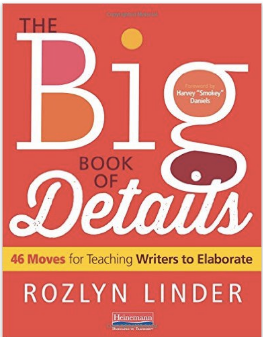|
|
Have you ever told a writer to add more details, only to see their writing get longer not better? That's why Roz Linder wrote The Big Book of Details. "To help our students use details and elaborate effectively," she writes, "we need to find out what they want their writing to do, and then show them explicit moves to make it happen."
Roz breaks elaboration into 5 categories and shares 46 lessons based on the moves that professional writers use. With if-then charts that connect student needs to just-right strategies, you'll help writers master details that:
In Writers Are Readers, the mutually supportive roles of reading and writing are made visible through the idea of "flipsides;" how a reader's insights can be turned around to provide insights into his own writing, and vice versa. Lester and Reba's trademark engaging style is woven throughout chapters full of sample lessons, student writing samples, and recommended texts for maximizing the flipped concept across the year. "Leading the student to understand what he did as a reader can become a lens that brings into focus what the writer had to do before a reader ever saw the page," they write. Discover fresh new ways to turn reading strategies into writing opportunities that your students will be excited about and deeply understand.
It's been said that good writers borrow while great writers steal. Writing thieves read widely, dive deeply into texts, and steal bits and pieces from great texts as models for their own writing. Ruth Culham admits to being a writing thief-and she wants you and your students to become writing thieves, too!
A major part of becoming a writing thief is finding the right mentor texts to share with students. Within this book, discover more than 90 excellent mentor texts, along with straight-forward activities that incorporate the traits of writing across informational, narrative, and argument modes. Chapters also include brief essays from beloved writing thieves such as Lester Laminack, David L. Harrison, Lisa Yee, Nicola Davies, Ralph Fletcher, Toni Buzzeo, Lola Schaefer, and Kate Messner, detailing the reading that has influenced their own writing. Ruth's beloved easy-going style and friendly tone make this a book you'll turn to again and again as you guide your students to reach their full potential as deep, thoughtful readers and great writers. There's a writing thief in each of us when we learn how to read with a writer's eye!
In Writing with Mentors, high school teachers Allison Marchetti and Rebekah O'Dell prove that the key to cultivating productive, resourceful writers-writers who can see value and purpose for writing beyond school-is using dynamic, hot-off-the-press mentor texts. In this practical guide, they provide savvy strategies for:
--finding and storing fresh new mentor texts, from trusted traditional sources to the social mediums of the day --grouping mentor texts in clusters that show a diverse range of topics, styles, and approaches --teaching with lessons that demonstrate the enormous potential of mentor texts at every stage of the writing process. In chapters that follow the scaffolded instruction Allison and Rebekah use in their own classrooms, you'll discover how using mentor texts can unfold across the year, from inspiration and planning to drafting, revising, and "going public" in final publication. Along the way, you'll find yourself reaching every writer in the room, whatever their needs. "Our hope in this book," they write, "is to show you a way mentors can help you teach anything you need or want to teach in writing. A way that is grounded in the work of real writers and the real reading you do every day. A way that is sustainable and fresh, and will serve your students long after they leave your classroom."
You'll refer to The Resourceful Writing Teacher time and again. Its teaching and learning strategies are understandable, accessible, and ready to implement. Bender establishes the specific teaching practices that help writers in grades 3-8 develop, giving you precise suggestions for minilessons, conferences, small-group strategy lessons, and shares.
Working through essential teaching points for writing narratives, writing non-narrative pieces, and using conventions, The Resourceful Writing Teacher forms an instructional blueprint that addresses the crucial skills writers need. Bender's ideas help students develop multiple strategies for internalizing skills such as:
In order to teach writing effectively, teachers must be writers themselves. They must experience the same uncertainty of starting a new draft and then struggling to revise. As they learn to move past the fear of failure, they discover the nervous rush and exhilaration of sharing work with an audience, just as their students do. Only by engaging in the real work of writing can teachers become part of the writing community they dream of creating for their students.
Kate Messner s new book, 59 Reasons to Write, shows teachers and librarians who teach writing how to be stronger role models for their students. 'Writing for my students provided me with appropriate mentor texts to share,' she writes. 'Writing with my students made me a mentor and a far better teacher.' 59 Reasons to Write grew out of Messner s popular online summer writing camp, Teachers Write. Throughout the book she offers mini-lessons, writing prompts, and bursts of inspiration designed to get you writing every day, whether on your own or as part of a group. Dozens of guest authors also share their writing processes and secrets, from brainstorming ideas and organizing research to developing characters and getting unstuck from writer s block. 59 Reasons to Write is for anyone who has always wanted to write but never managed to get into the habit. Daily warm-ups will help you flex your writing muscles and energize your teaching. As Messner shares, 'One of the greatest gifts of writing is the way it nudges us to look more closely not only at the world but also at ourselves.' |












